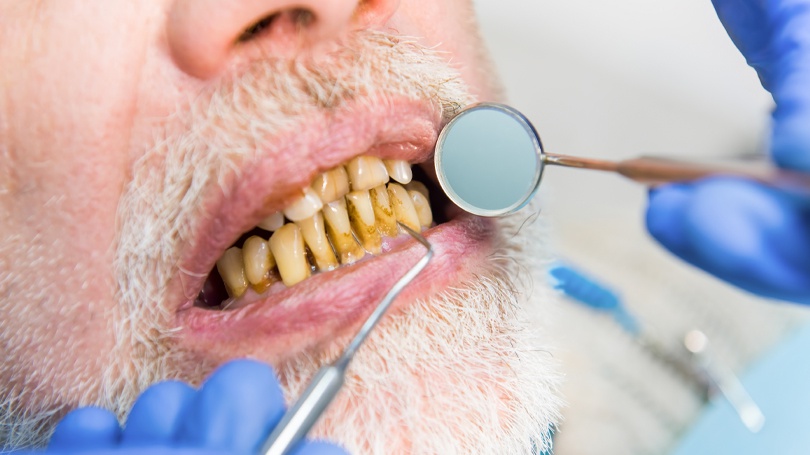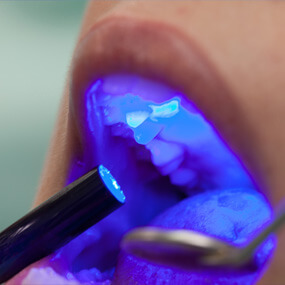Tooth Decay: Causes, Symptoms and Treatment

Tooth decay is an oral disease and among the most prevalent of human diseases. The Centers for Disease Control and Prevention warns that 90 percent of Americans age 20 and up have some degree of tooth decay. Cavities—also known as dental caries—are highly preventable, but the potential for decay is ongoing throughout your life due to interactions between food, bacteria, saliva, and your teeth.
The Process of Tooth Decay
Your mouth is home to many bacteria. The first step of tooth decay occurs as you chew food and break it down into carbohydrates. Bacteria interacts with those carbohydrates and creates acid. Those acids can directly erode your tooth enamel but present an even bigger problem. They interact with your saliva and the food particles in your mouth to create a sticky biofilm called plaque. Plaque contains acids that can erode enamel and bacteria that can infect your gums and even your bones eventually.
Plaque continues to accumulate. As it does, the attacks against your teeth intensify. In addition, the plaque can spread, which is often how it gets under the gums, where it can cause an infection. Undisturbed, plaque will harden into tartar—also known as dental calculus—which exacerbates the problem because it is not removable through normal brushing and flossing. It also provides additional surface area for plaque and hastens the spreading of plaque throughout the mouth.
Tooth enamel attacked by acid can be restored through remineralization, such as with fluoride. But if the situation is not controlled, the acid will eventually compromise the enamel, and there are certain health conditions that can make a person more prone to this occurring. While decay is limited to the enamel initially and even reversible, it will eventually reach the dentin and the tooth pulp.
The Causes of Tooth Decay
Acids and bacteria are what directly leads to tooth decay. The formation of plaque is an ongoing process in your mouth, no matter how well-balanced and oral-health-friendly your diet is. Consider that acids are attacking your teeth as soon as you eat or drink something. They can continue to attack your teeth for up to 20 minutes after, and if you are sipping a carbonated soft drink, for instance, they can be under constant attack for a lot longer than that. Factors that make you more prone to tooth decay include:
- Diabetes
- Dry mouth
- Cigarettes and other tobacco use
- Secondhand smoke
- Poor oral hygiene at home
- Lack of professional dental cleanings
- A diet high in sugars, carbohydrates, and acids
- Not getting enough fluoride
The Symptoms of Tooth Decay
Tooth decay often does not cause symptoms early on, which is why it is so important to see your dentist for preventive care. Cavities can be small and hard to notice with the naked eye, and you will generally not experience sensitivity or discomfort until the decay reaches the dentin. Sings to watch for include:
- Toothaches
- Persistent bad breath
- Frequent unpleasant tastes in the mouth
- Gray, brown, or black spots on your teeth
- Sensitivity to hot, cold, or sweet
- Tenderness or pain when chewing
Tooth Decay Prevention
Despite the prevalence of cavities in adults and children, they are highly preventable. Avoiding tooth decay is a matter of consistent oral hygiene and preventive dental care. You should:
- Brush twice a day for two to three minutes.
- Brush with a soft-bristled brush and fluoride toothpaste.
- Floss your teeth twice a day.
- Eat a well-balanced diet and opt for healthy snacks.
- Discuss supplemental fluoride treatments with your dentist.
- Consider dental sealants, which make you less prone to plaque.
- Visit your dentist biannually for a cleaning and exam.
Tooth Decay Treatment
A benefit of regular dental visits is that your dentist can identify cavities in the earliest stages. When the decay is limited to the enamel, it can be treated through remineralization. This can be accomplished with coatings, fillings, pastes, or rinses that contain calcium, fluoride, or phosphate. Note, however, that remineralization is not always successful, so it is best to aim to avoid the issue in the first place.
Calcium, fluoride, and phosphate are essential to the strength and health of your tooth enamel. This is why regular exposure to fluoride is so important. You should also ensure a diet that is rich in calcium, vitamin D, potassium, phosphorus, and vitamin C. Along with hydration, this will make you less prone to cavities.
Advanced tooth decay is decay that has reached the dentin, cementum, or tooth pulp. Left untreated, you can lose the tooth, but before that, bacteria will cause an infection. Such infections can be excruciatingly painful and lead to an abscess. The infection can extend beyond the tooth and the gums local to it to other areas of the mouth, including the jawbone, and, in some rare cases, even beyond it.
Treatment for advanced tooth decay depends on the extent of the deterioration. If the infected area is relatively small, your dentist can remove that area and fill it with composite resin. If the structure of the tooth is undermined, your dentist may place a crown over it. When the pulp is infected, root canal therapy followed by placing a crown is the usual treatment required. If the tooth cannot be saved, your dentist will extract it and can then replace it with an implant or another type of oral restoration.
Keep Your Teeth Free of Decay
Visiting your dentist every six months—even when your teeth look and feel fine—is essential to preventing tooth decay. In the event you do get a cavity, it will be caught early and may even be reversible. Tooth decay is much cheaper and less invasive to treat when diagnosed in the initial stages, and Jeffrey D. Clark, DDS, can do that with a simple examination. Call Scottsdale Cosmetic Dentistry Excellence at 480 585 1853 with any questions you may have and to schedule a checkup or tooth decay treatment.




